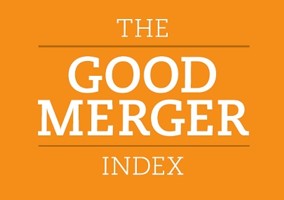Richard Litchfield, chief executive of Eastside Primetimers, says that "backwards mergers" are the way forwards for the charity sector.
While charity mergers may remain rare, our recent report the Good Merger Index found that there are valuable lessons and examples of innovation from those organisations which did decide to join forces in 2017.
One of the most interesting arrangements is the creation of the YMCA St Paul’s Group, where a merger between YMCAs in South West London and East London has led to a further amalgamation with YMCA West London and the acquisition of YMCA Slough. This is intended to harness the best of all these organisations and take a strategic view of the services they deliver for young, vulnerable and homeless people across London. The group will now manage over 1,150 units of accommodation in 20 London Boroughs.
'Aligning policies and systems first'
The chief executive of the new group Richard James is candid that undertaking multiple mergers has enabled them to learn by doing and hone the process of amalgamation, resulting in them merging “backwards” with YMCA West London. This meant aligning policies and systems first to get the organisations working closely in a similar way, before completing the legal formalities of merger. For example, they coordinated vital safeguarding policies around children, mirrored staff structures and undertook joint recruitment exercises. Each had previously been paying for their own HR software and they integrated these into one system early, helping to achieve cost synergies quickly. We have seen examples of this kind of “backwards” approach before. For instance, neighbouring Suffolk leisure trusts Abbeycroft and Anglia Community hired a joint chief executive for two years to run both organisations before finally completing a merger.
'Do something different'
The YMCA effort came about from an internal review following their first merger, which revealed an opportunity to “do something different” and pursue crucial day-to-day integration upfront. This enabled misunderstandings and staff anxieties to be ironed out earlier, reducing fears about a “takeover” in culture and creating a more collaborative environment.
This is not for the faint-hearted and conditions had to be met to make this idea a reality. There has to be a high degree of certainty that the formal merger will go ahead. Towards this, the YMCAs developed a clear business case, got backing from both Boards and received legal assurances in advance. They then continued to communicate the benefits of merger to team members while business convergence occurred so that internal support was maintained for full merger, avoiding the risk that staff might have felt the gains from closer working had already been realised.
This approach flows from a good rapport, a deep well of trust and crystal-clear communication between the two merging organisations. The fact the YMCAs are part of the same federated family certainly helped but there was still work to do because the cultures of separate YMCA branches can start out very different, despite the common brand. In fact Richard James believes so long as the trust exists there is no reason why two distinct charities couldn’t replicate this approach.
This is an exciting development for geeks like me who are interested in charity mergers. Only in the not-for-profit sector, where the focus of a merger is ultimately the common good rather than price, is this kind of advanced integration even possible. It represents a way for the charities and social enterprises to merge in a way that is tailored to their ethos and give themselves the very best chance of making a quick start to realising the benefits of joining forces.
Richard Litchfield is chief executive of Eastside Primetimers
Related articles











